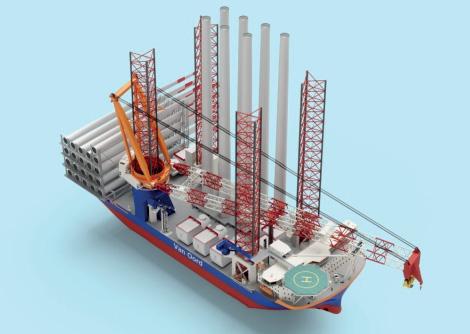
4 minute read
Retrofi t solution
METHANOL CONVERSIONS POSSIBLE FOR ALL W32 ENGINES
Adding dual-fuel capability to existing engines will be easy, Wärtsilä says
More than 2,000 Wärtsilä 32 engines are already in service, across a wide spectrum of ship types, and all of them could be converted to run on methanol, according to Toni Stojcevski, the engine designer’s general manager, sales.
It is now seven years since Stena Germanica’s Wärtsilä ZA40S engines were converted to use methanol, and next year the technology will be available for Wärtsilä 32 engines, followed by Wärtsilä 20 units in 2024 and Wärtsilä 46F/FDF installations in 2025, he told attendees of a Wärtsilä webinar to launch the methanol version of the Wärtsilä 32 in late March.
To meet IMO’s target of reducing shipping’s total GHG emissions by 50% compared to 2008 levels by 2050, newbuildings will eventually have to be zero-carbon vessels, “but unfortunately, that technology is not available today”, he said. Until then, “the best way to lower CO2 emissions is to convert to alternative fuels such as methanol”.
In fact, “getting the engine to run on methanol is the easy part”, he said. “The biggest challenge is finding space for fuel.” Because it has a lower energy density than MGO, the volume of methanol needed is about 2.5 times that required for MGO. When the space taken up by cofferdams is considered – which is required for both fuels – the total tank space increases by a factor of about 1.6, he explained.
Fortunately, because methanol is a liquid at normal temperatures and pressures, double bottom tanks or void spaces could be repurposed to store fuel, he said.
On the engine itself, Stojcevski listed the main components that need changing: 5 Cylinder heads: For methanol fuel, the cylinder heads have to accommodate a larger injector that delivers methanol, diesel and sealing oil, which prevents any methanol leakage in the injector escaping into the engineroom. 5 Piping: Additional piping is required to supply methanol to the common rail, along with a return line. Further pipes
deliver the sealing oil and control oil, which operates the electro-hydraulic fuel injection system. 5 Automation system: A new automation system is needed to suit the dual fuels and electronic injection timing. It would be replaced with Wärtsilä’s Unified Controls (UNIC) system, which handles start/stop management, engine safety, fuel management, speed/load control, charge air, cooling and combustion.
Stojcevski also discussed the implications of the dual fuel arrangement, saying that in the event that the methanol supply fails, because the same pump and injector delivers both fuels, the diesel supply would increase and the engine would continue running without interruption.
At 85% load, about 8% of the fuel energy is delivered by the pilot diesel oil but because the same injector must be capable of delivering sufficient diesel for full output, “the limitation is not that the methanol needs the 8% in order to combust, but that we cannot technically inject less fuel”, Stojcevski said. “It is a very robust and reliable system.”
8 Van Oord’s wind
installation vessel will be the fi rst to be fi tted with methanol-fuelled Wärtsilä 32 engines
Why choose methanol?
Van Oord explains why methanol is right for its new jack-up.
Details have emerged about the thinking behind Van Oord’s decision to place the first newbuild order for a methanol-fuelled Wärtsilä 32 engine, reported by The Motorship on 25 January. Five of the engines will provide propulsion power for a jack-up offshore wind installation vessel on order at China’s Yantai CIMC Raffles shipyard and the engines will be delivered early next year.
Speaking during a Wärtsilä webinar in late March, Van Oord’s innovation manager Job Voormolen said that its choice of methanol rather than LNG was because “the uncertainty of last-minute changes is common practice” in the marine contracting world.
LNG is not ideal for that way of working because it is cryogenic and once it has been bunkered, “you want to make sure that you consume enough to keep the tank pressure down”. This complicates operational planning, so “we decided that this was not the way for us”, he said.
Methanol, on the other hand, is liquid at ambient temperature so it does not create those constraints, making it “the straight path to net zero”, he said.
This matches its corporate strategy, which is to achieve net zero emissions from its fleet in 2050, “and our fleet is responsible for 95% of our carbon footprint”, which can only be achieved by improving energy efficiency and by using renewable energy, he said.
Its decision was also based on feedback from its key customers along with its expectations of the impact of legislation from IMO and the EU on its business and future fleet. Taking all that into account, “we feel that the use of methanol for this particular type of jack-up vessel would be an ideal combination”.
That still left another important decision: whether to operate the vessel on methanol from delivery or design it as ‘methanol-ready’ and plan for a mid-life upgrade. However, visits to the methanol-fuelled and Wärtsilä-engined ferry Stena Germanica to understand its operation and maintenance, coupled with a review of the complexity of a midlife upgrade, “made us push for a full methanol vessel, including sea trials from the start”, Voormolen said.





